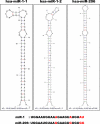microRNA-1/133a and microRNA-206/133b clusters: dysregulation and functional roles in human cancers
- PMID: 22308266
- PMCID: PMC3292888
- DOI: 10.18632/oncotarget.424
microRNA-1/133a and microRNA-206/133b clusters: dysregulation and functional roles in human cancers
Abstract
MicroRNAs (miRNAs) are endogenous short non-coding RNA molecules that regulate gene expression by repressing translation or cleaving RNA transcripts in a sequence-specific manner. A growing body of evidence suggests that miRNAs are aberrantly expressed in many human cancers and that they play significant roles in the initiation, development and metastasis of human cancers. Genome-wide miRNA expression signatures provide information on the aberrant expression of miRNAs in cancers rapidly and precisely. Recently, studies from our group and others revealed that microRNA-1 (miR-1), microRNA-133a (miR-133a), microRNA-133b (miR-133b) and microRNA-206 (miR-206) are frequently downregulated in various types of cancers. Interestingly, miR-1-1/miR-133a-2, miR-1-2/miR-133a-1, and miR-206/miR-133b form clusters in three different chromosomal regions of the human genome - 20q13.33, 18q11.2 and 6p12.1, respectively. Here we review highlights of recent findings on the aberrant expression and functional significance of the miR-1/miR-133a and miR-206/miR-133b clusters in human cancers.
Figures





Similar articles
-
miR-145, miR-133a and miR-133b: Tumor-suppressive miRNAs target FSCN1 in esophageal squamous cell carcinoma.Int J Cancer. 2010 Dec 15;127(12):2804-14. doi: 10.1002/ijc.25284. Int J Cancer. 2010. PMID: 21351259
-
Identification of pyruvate kinase type M2 as potential oncoprotein in squamous cell carcinoma of tongue through microRNA profiling.Int J Cancer. 2008 Jul 15;123(2):251-257. doi: 10.1002/ijc.23583. Int J Cancer. 2008. PMID: 18464261
-
Novel molecular targets regulated by tumor suppressors microRNA-1 and microRNA-133a in bladder cancer.Int J Oncol. 2012 Jun;40(6):1821-30. doi: 10.3892/ijo.2012.1391. Epub 2012 Feb 29. Int J Oncol. 2012. PMID: 22378464
-
Functional significance of aberrantly expressed microRNAs in prostate cancer.Int J Urol. 2015 Mar;22(3):242-52. doi: 10.1111/iju.12700. Epub 2015 Jan 20. Int J Urol. 2015. PMID: 25599923 Review.
-
Aberrant expression of microRNAs in bladder cancer.Nat Rev Urol. 2013 Jul;10(7):396-404. doi: 10.1038/nrurol.2013.113. Epub 2013 May 28. Nat Rev Urol. 2013. PMID: 23712207 Review.
Cited by
-
miR-1 suppresses the growth of esophageal squamous cell carcinoma in vivo and in vitro through the downregulation of MET, cyclin D1 and CDK4 expression.Int J Mol Med. 2016 Jul;38(1):113-22. doi: 10.3892/ijmm.2016.2619. Epub 2016 May 31. Int J Mol Med. 2016. PMID: 27247259 Free PMC article.
-
MiR-93 enhances angiogenesis and metastasis by targeting LATS2.Cell Cycle. 2012 Dec 1;11(23):4352-65. doi: 10.4161/cc.22670. Epub 2012 Oct 30. Cell Cycle. 2012. PMID: 23111389 Free PMC article.
-
Aberrant expression of a five-microRNA signature in breast carcinoma as a promising biomarker for diagnosis.J Clin Lab Anal. 2020 Feb;34(2):e23063. doi: 10.1002/jcla.23063. Epub 2019 Oct 8. J Clin Lab Anal. 2020. PMID: 31595567 Free PMC article.
-
MiR-1 Suppresses Proliferation of Osteosarcoma Cells by Up-regulating p21 via PAX3.Cancer Genomics Proteomics. 2019 Jan-Feb;16(1):71-79. doi: 10.21873/cgp.20113. Cancer Genomics Proteomics. 2019. PMID: 30587501 Free PMC article.
-
Combined downregulation of microRNA-133a and microRNA-133b predicts chemosensitivity of patients with esophageal squamous cell carcinoma undergoing paclitaxel-based chemotherapy.Med Oncol. 2014 Nov;31(11):263. doi: 10.1007/s12032-014-0263-6. Epub 2014 Oct 4. Med Oncol. 2014. PMID: 25280517
References
Publication types
MeSH terms
Substances
LinkOut - more resources
Full Text Sources
Other Literature Sources
Molecular Biology Databases

